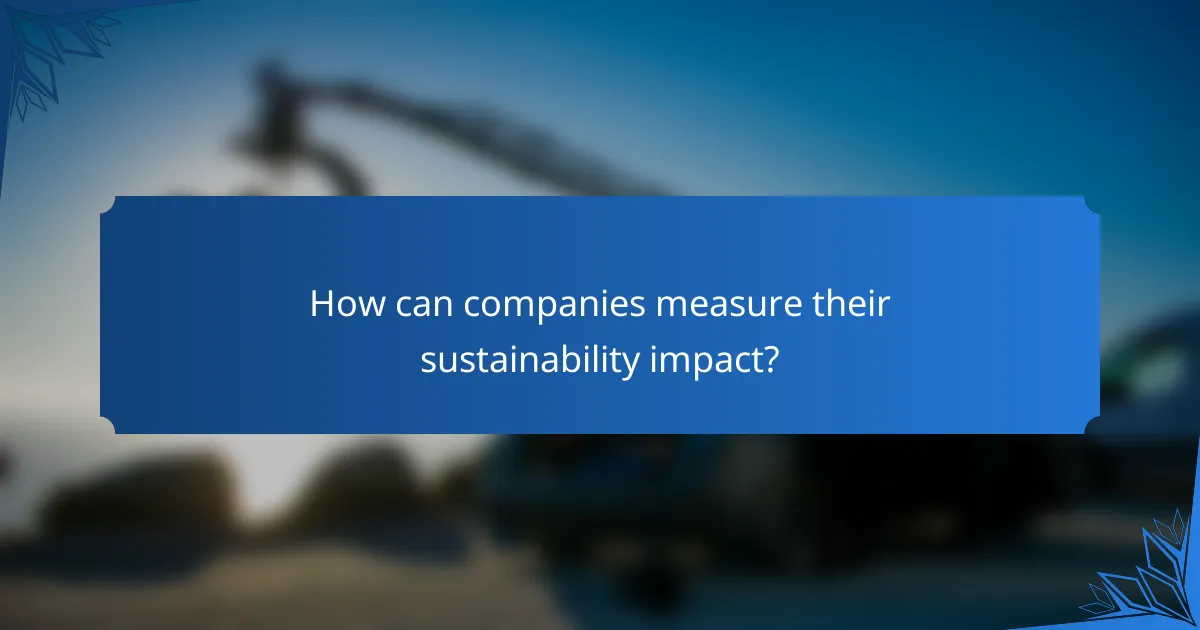As sustainability trends continue to evolve, businesses in the United States are increasingly adopting innovative practices aimed at reducing their environmental impact. Key focus areas such as renewable energy, waste reduction, and sustainable farming not only enhance operational efficiency but also improve brand reputation among eco-conscious consumers. By prioritizing sustainability, organizations can achieve cost savings and ensure compliance with stringent regulations, positioning themselves favorably in a competitive market.

What are the current sustainability trends in the United States?
Current sustainability trends in the United States focus on reducing environmental impact through innovative practices across various sectors. Key areas include renewable energy, waste reduction, sustainable farming, corporate responsibility, and green building standards.
Renewable energy adoption
Renewable energy adoption is rapidly increasing in the U.S., driven by technological advancements and supportive policies. Solar and wind power are leading the charge, with many states aiming for significant renewable energy targets by 2030.
Homeowners and businesses are increasingly investing in solar panels, often benefiting from federal tax credits and state incentives. This trend not only reduces electricity costs but also contributes to lower carbon emissions.
Zero-waste initiatives
Zero-waste initiatives aim to minimize waste through comprehensive recycling and composting programs. Many cities are adopting these strategies to divert waste from landfills and promote circular economies.
Businesses are encouraged to redesign products and packaging to be reusable or recyclable. Simple actions, like reducing single-use plastics and implementing composting systems, can significantly impact waste reduction efforts.
Sustainable agriculture practices
Sustainable agriculture practices focus on environmentally friendly farming techniques that enhance soil health and reduce chemical use. Methods such as crop rotation, organic farming, and integrated pest management are gaining traction among farmers.
Consumers are increasingly seeking locally sourced and organic products, which supports sustainable farming and reduces transportation emissions. Community-supported agriculture (CSA) programs are also popular, connecting consumers directly with local farmers.
Corporate social responsibility
Corporate social responsibility (CSR) is becoming a priority for many U.S. companies, as consumers demand ethical practices and transparency. Businesses are integrating sustainability into their operations, from supply chain management to employee engagement.
Companies often publish sustainability reports outlining their environmental impact and goals. Engaging in community initiatives and supporting local environmental projects can enhance a company’s reputation and customer loyalty.
Green building standards
Green building standards, such as LEED (Leadership in Energy and Environmental Design), are increasingly adopted in the construction industry to promote energy efficiency and sustainability. These standards guide the design, construction, and operation of buildings to minimize their environmental footprint.
Incorporating energy-efficient systems, sustainable materials, and water-saving technologies can lead to significant cost savings over time. Homebuyers and tenants are often willing to pay a premium for green-certified buildings, reflecting a growing market demand for sustainable living spaces.

How do sustainability practices impact businesses?
Sustainability practices significantly impact businesses by enhancing operational efficiency, improving brand reputation, and attracting a growing segment of eco-conscious consumers. These practices can lead to cost savings and ensure compliance with increasingly stringent regulations.
Cost savings through efficiency
Implementing sustainability practices often leads to cost savings by improving operational efficiency. For example, businesses that invest in energy-efficient technologies can reduce their utility bills by up to 20-30%. Streamlining waste management processes can also lower disposal costs and minimize resource consumption.
To maximize these savings, companies should regularly assess their resource usage and identify areas for improvement. Simple steps like upgrading to LED lighting or optimizing supply chain logistics can yield significant financial benefits over time.
Enhanced brand reputation
A strong commitment to sustainability can enhance a company’s brand reputation, making it more appealing to consumers and investors. Companies recognized for their environmental efforts often enjoy increased customer loyalty and positive media coverage. This can translate into higher sales and a competitive edge in the market.
To build a reputable brand, businesses should communicate their sustainability initiatives clearly and authentically. Engaging in community projects or obtaining certifications like ISO 14001 can further solidify their commitment to sustainable practices.
Attracting eco-conscious consumers
Eco-conscious consumers are increasingly seeking products and services that align with their values. Businesses that adopt sustainable practices can tap into this growing market segment, which is willing to pay a premium for environmentally friendly options. Research indicates that a significant portion of consumers prioritize sustainability when making purchasing decisions.
To attract these consumers, companies should highlight their sustainable practices in marketing materials and product labeling. Transparency about sourcing, production methods, and environmental impact can foster trust and encourage purchases from eco-aware shoppers.
Compliance with regulations
Adopting sustainability practices helps businesses comply with environmental regulations, which are becoming more stringent worldwide. Non-compliance can lead to hefty fines and damage to reputation. By proactively integrating sustainable practices, companies can mitigate risks associated with regulatory changes.
Staying informed about local and international regulations is crucial. Businesses should regularly review their operations to ensure they meet or exceed legal requirements, such as waste disposal standards and emissions limits. Engaging with industry groups can provide valuable insights into upcoming regulatory trends.

What are the benefits of adopting sustainable practices?
Adopting sustainable practices offers numerous advantages, including enhanced reputation, cost savings, and improved operational efficiency. Organizations that prioritize sustainability can attract customers and investors who value environmental responsibility.
Improved employee morale
Implementing sustainable practices can significantly boost employee morale. When employees see their organization committed to environmental stewardship, they often feel more engaged and proud of their workplace.
Companies can foster this morale by involving employees in sustainability initiatives, such as recycling programs or energy-saving campaigns. This involvement not only enhances job satisfaction but can also lead to increased productivity.
Access to new markets
Adopting sustainable practices can open doors to new markets, particularly among consumers who prioritize eco-friendly products. Businesses that align their offerings with sustainability trends can tap into a growing demographic that is willing to pay a premium for green products.
For example, companies in the fashion industry that use organic materials or sustainable manufacturing processes often find new customer bases. Additionally, certifications like Fair Trade or Energy Star can help businesses stand out in competitive markets.
Long-term viability
Embracing sustainability is crucial for long-term viability in today’s economy. Organizations that fail to adapt to environmental regulations or consumer preferences may face significant risks, including financial penalties and reputational damage.
Investing in sustainable practices can lead to cost savings over time, such as reduced energy consumption and waste management costs. Companies should regularly assess their sustainability strategies to ensure they remain competitive and compliant with evolving standards.

What frameworks guide sustainability efforts?
Several frameworks guide sustainability efforts, providing structured approaches to achieving environmental, social, and economic goals. These frameworks help organizations align their practices with global standards and improve their sustainability performance.
United Nations Sustainable Development Goals
The United Nations Sustainable Development Goals (SDGs) consist of 17 interconnected objectives aimed at addressing global challenges, including poverty, inequality, climate change, and environmental degradation. Adopted in 2015, these goals serve as a universal call to action for countries, organizations, and individuals to work towards a more sustainable future.
To implement the SDGs, organizations can start by assessing their current impact and identifying which goals align with their mission. For instance, a company in the food industry might focus on Goal 2 (Zero Hunger) by promoting sustainable agriculture practices. Regularly measuring progress against these goals can enhance accountability and drive continuous improvement.
ISO 14001 Environmental Management
ISO 14001 is an internationally recognized standard for establishing an effective Environmental Management System (EMS). This framework helps organizations improve their environmental performance through more efficient resource use and waste reduction. It emphasizes a systematic approach to managing environmental responsibilities and integrating them into business processes.
To adopt ISO 14001, organizations should conduct an initial environmental review, set measurable objectives, and develop a plan to achieve them. Regular audits and management reviews are crucial for maintaining compliance and identifying areas for improvement. For example, a manufacturing firm might implement ISO 14001 to reduce energy consumption by 10% over five years, thereby lowering costs and minimizing its carbon footprint.

How can companies measure their sustainability impact?
Companies can measure their sustainability impact through various metrics and frameworks that evaluate environmental, social, and governance (ESG) performance. Key methods include carbon footprint analysis, sustainability reporting, and stakeholder engagement, which help organizations understand their contributions to sustainability goals.
Carbon footprint analysis
Carbon footprint analysis quantifies the total greenhouse gas emissions produced directly and indirectly by a company. This assessment typically includes emissions from energy use, transportation, waste, and supply chain activities, providing a comprehensive view of a company’s environmental impact.
To conduct a carbon footprint analysis, companies can follow the Greenhouse Gas Protocol, which categorizes emissions into three scopes: Scope 1 (direct emissions), Scope 2 (indirect emissions from purchased electricity), and Scope 3 (all other indirect emissions). This structured approach helps identify key areas for improvement.
Companies should regularly review their carbon footprint and set reduction targets. For example, aiming to reduce emissions by 20-30% over five years can be a practical goal. Additionally, investing in renewable energy sources and improving energy efficiency are effective strategies to lower overall emissions.



